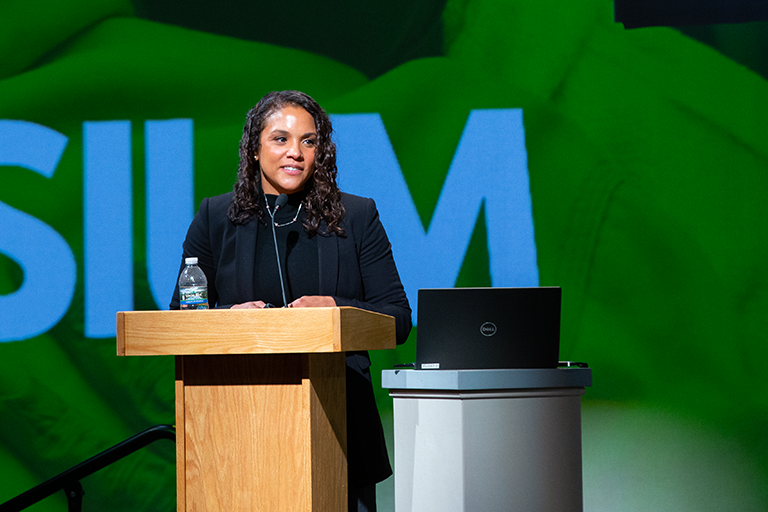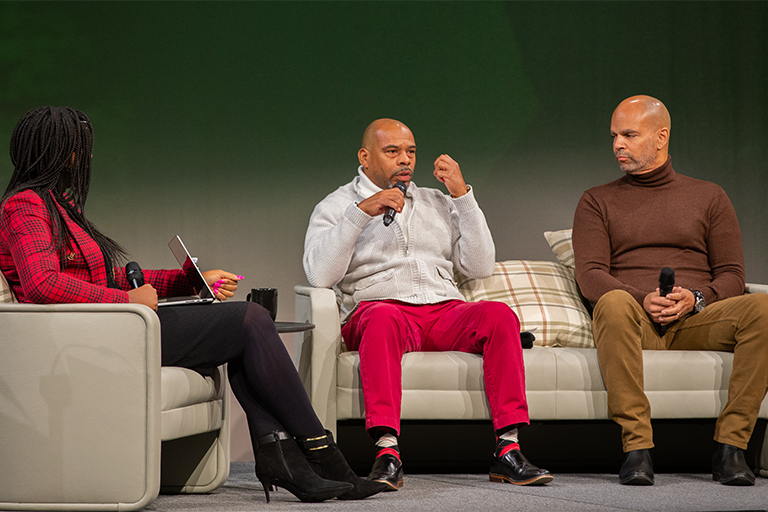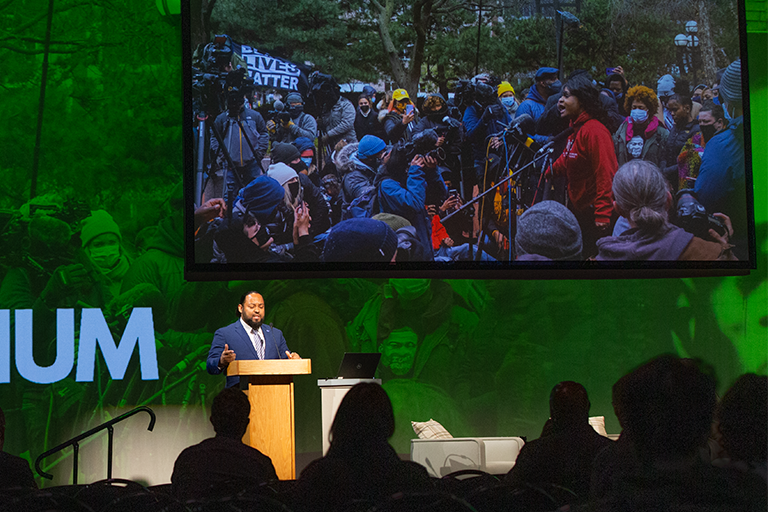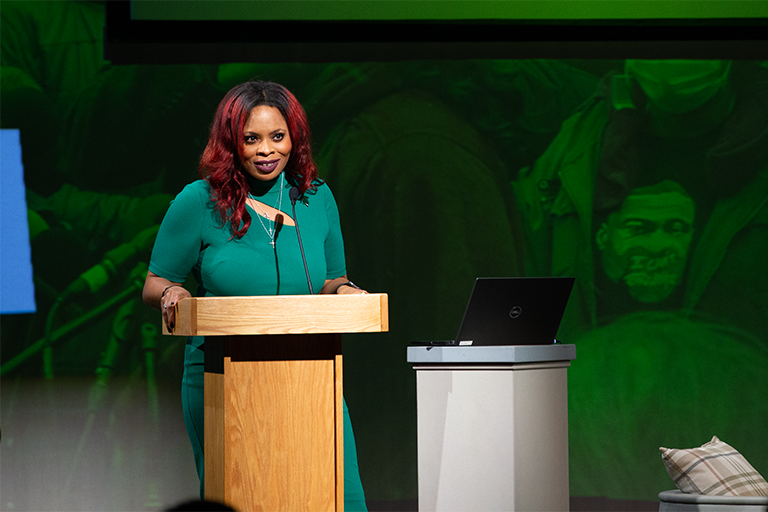The significance of the LIFT Project extends beyond academia, challenging journalists to envision a future where trust is nurtured, diversity thrives and the volume of unheard voices is amplified. As narrative change unfolds, the LIFT Project invites the journalism community to join its journey — one story at a time.
Lessons for Journalism from Ground Zero of the 2020 Racial Reckoning
Academics and journalists from across the Midwest gathered in the WKAR studios last month, following a flame sparked by Danielle K. Brown, 1855 Professor of Community and Urban Journalism at Michigan State University.
As a journalist and researcher, Brown’s dedication to unraveling the narratives surrounding Black people, police violence and protests was challenged in the aftermath of the racial reckoning that followed George Floyd’s murder in Minneapolis, Minnesota. From ground zero in Minnesota, she launched an unflinching and thorough research investigation of the media landscape and community needs. The LIFT Project, with initial funding from the John S. and James L. Knight Foundation, officially began in 2022 — collecting data that would help her and her team identify ways to fight mis- and disinformation in and about Black communities.
Brown’s team sought to meet the dynamic landscape of news coverage — where stories hold the power to shape perceptions and catalyze change — with the might of academia. Those findings and implications for the industry were revealed at the Nov. 2 LIFT Symposium x Neal Shine Lecture, hosted by Michigan State University’s School of Journalism.
“This is an important event for the School of Journalism,” said Tim Vos, professor and director of the J-School. “We seek to be a learning community, and this is an opportunity for learning, for intellectual stimulation, but also a time for reflection and thinking about how we can do our work better.”
What is the LIFT Project?
Video: Analyzing Media Coverage of George Floyd Protests | Unraveling Racial Narratives from WKAR on YouTube.
Narrative Change in the Industry
Research for the LIFT Project centered on local communities and news coverage and began in Minneapolis/St. Paul. Her team conducted content analyses, surveys and interviews to understand the dynamics of media coverage — particularly focusing on the relationships between racialized issues, the local media system, Black communities and trust.
“Many of the news organizations in Minneapolis promised to change,” Brown said. “We wanted to know what that coverage looks like. You promised change. Did it come?”
The team found instances of forward movement that surprised Brown, but too often those stories made less impact than destructive journalism speaking to a specific demographic audience and reinforcing harmful stereotypes. Brown said that one of the biggest lessons she learned in Minneapolis was that while patterns helped her identify the change that didn’t come, they couldn’t give her the full picture.
Living in Minneapolis gave her more insight.
“I got to meet with journalists and see the struggle to produce that one good story that my numbers couldn’t account for. There were people who were making narratives in the mainstream and beyond, making narratives that humanized Black life, that showed the nuance of what was going on in the space,” Brown said. “And my numbers simply couldn’t give legend to that, which is what the LIFT project hopes to do today. No matter how much journalism excels, I think the problem is that we’ve created a legacy of harm.”

“The narratives aren’t perfect. And they don’t look equitable. But there are signs of improvement that we have to celebrate and that we have to think about, or we can’t engage in anything deliberative that makes anything work.” — Danielle K. Brown
Taking Care of Trusted Messengers
Among many notable lessons, the LIFT Project revealed an uncomfortable reality: one wrong can undo a lot of rights. In the hearts and minds of a community, the damage can be irreparable … and this can signal a mass exodus of an audience, or even newsroom staff.
LIFT’s content analysis and surveys demonstrated a need for institutions to focus on repairing lost faith among their communities, both by appropriately framing content and leaning into trusted messengers. In the Midwest, Black journalists — like guests Daniel Bergin, Harry Colbert Jr., Suzette Hackney, JaNaé Bates, Libor Janey and Kyndell Harkness — were among those trusted messengers. However, the surveys also highlighted key members of a community not associated with the traditional media to be a trusted source of information, revealing opportunities for new and impactful partnerships.
Assistant Professor and LIFT Research Associate Christina L. Myers also stressed the importance of news organizations learning to engage in trauma-informed practices, and not just out in the field. Providing tools and spaces inside of the workplace where journalists can support one another, especially while covering heavy subject matter that may feel deeply personal, can help ease the emotional burden carried by staff.
“What I hope to continue to contribute is this idea of restoration,” Myers said of her work with the LIFT Project. “Not only restoration in terms of the sense of trust that we’ve talked about with our communities — really bridging the gap and being in the community and building these partnerships – but this restoration in our workspaces as journalists. And how we can partner together to use our research to help cultivate those spaces and use the data to show the evidence as to why all this matters.”

Photo: From left to right — Dr. Denetra Walker, Harry Colbert, Jr., Daniel Bergin.
“I’m very much a mission-based journalist. I don’t make any bones about it. I’m very purposeful in my actions and in my reporting, and in the reporting that I have my reporters do. And it’s affirming that I’m doing it for the right reasons.” — Harry Colbert, Jr.
Representation Matters
When journalists are unable to find enough fulfilment and reprieve, they might pack up and start over in a new community. Brown noted that many Black journalists are choosing to leave the industry entirely. The trust those journalists have earned with an audience — and the unique stories they still want to tell — leave with them.
The value of equity and diverse representation within a media outlet cannot be understated. The late Neal Shine, long-time editor and publisher of the Detroit Free Press, knew this well; Kyndell Harkness, photojournalist and newly minted Head of Community and Culture at the Minnesota Star Tribune, illustrated the same throughout the Shine lecture.
In 2020, Harkness was a photo editor when her publication was covering George Floyd’s murder. She remembers being the only Black person in the room while decisions were being made about headlines, stories, story tone and image selection.
Harkness grappled with whether her colleagues would be “ready” for what she had to say but knew there was too much at stake to stifle her voice. She said, “Our city had been through Jamar Clark, Philando Castile … If there was any moment, it was now. To be as authentic and honest about how I feel in this moment and what this moment means to me, but also reflecting how we handle things and what that would mean to [the community].”
Because of those moments of radical honesty, Harkness found that others within the organization also felt empowered to speak their truth. She sees this change, and the fact that the Minnesota Star Tribune is now hearing different voices and asking different questions — who is at the table for this conversation, and who is not — as a sign of positive change in the landscape. However, this Spartan alumna notes that there is still so much more work to do, and she’s ready to help lead that charge.
Meanwhile, MSU’s J-School faculty are building additional pathways to mentor students and show the next generation of journalists what is possible in the field.
“If the industry wants more diverse journalists and visual journalists, we have to build infrastructure that allows us to train those journalists and help them get to where they want to go,” said Artist in Residence and LIFT Research Associate Jarrad Henderson.
Henderson is the founder of Pop-Up Docs, a mobile video editing multimedia studio providing skills-building workshops for aspiring storytellers from underrepresented populations. By removing the barriers to access — equipment, training, mentorship, building a portfolio to compete for scholarships — he seeks to help democratize journalism in the visual space.

Photo: From left to right — Jarrad Henderson, Kyndell Harkness.
“We have to, as news organizations, change the water in which these people are working in. And how you do that is, one: changing culture.” — Kyndell Harkness
Visual Journalists Do It Better
Brown emphasized that there are important lessons to be learned from visual journalists. “We under-celebrate them and the work that they do, and they are actually producing some of the most humanizing work that we can do for our communities of color and people of color. And it is good to look more into that in academia,” she said.
Visual journalists like Henderson understand the degree of empathy required for excellent on-location storytelling. “It’s a major ask when you put your lens in someone’s face ... when you ask to share time and space with someone, when you have to be there to capture the moment,” Henderson said. “Spending time with people being vulnerable, being as open as you're asking them to be, helps us build relationships.”
Henderson worked with a team comprised entirely of Black journalists that “parachuted” into Minneapolis, embedding themselves in the community for two months in 2021. Suzette Hackney, national columnist for USA Today and another J-School alumna, was a writer on that team. Part of what made the work they produced together so impactful was leaning into the process of building trust and relationships with sources, spending time talking to as many residents and activists as they could ... many of whom would never appear in a story, their interactions never recorded.
But that wasn’t the point. They needed to understand who this community was to portray an accurate, empathetic view of the city.
“Centering their voice — that is the key,” said Myers. “We get so caught up in the technicalities of trying to create our stories and the strong lead and things of that nature. But we want to make sure we get down to the humanity of the piece, and we find that through centering those voices.”

“Visual journalists can only be present in the present. I think that requires a level of honesty, of vulnerability, of being able to let your intention be known early and often. And an opportunity for continuous consent, because how somebody feels in the moment … might change as you spend more time with them.” — Jarrad Henderson
Finding Joy + the Future of LIFT
Despite the myth that reporters can check their identities at the door, journalists wish to be seen as the multi-faceted human beings that they are. For Myers, rediscovering the joy and purpose in her work as a journalist went hand-in-hand with embracing her authentic self — and feeling empowered to do so.
Suzette Hackney noted that while those months in Minneapolis resulted in some of the most dynamic, painful journalism she had ever done, it was also one of the best experiences of her career. They were given a “dream team,” and they were given time.
For Kyndell Harkness, helping drive companywide culture change from the inside is exciting — but so is being in the field and interacting with communities, and a healthy balance of both is needed for her to feel fulfilled.
Maintaining trust networks and supporting resilience for trusted messengers, including those in newsrooms, will be a continued focus for the LIFT Project.
The Minnesota LIFT Reports were just the beginning. The team hopes to use the same methods to see if the findings of Minneapolis/St. Paul are replicable in other areas of the Midwest. Are there unique challenges, needs and desires from the communities and trusted messengers in Detroit, Chicago, Saint Louis, Kansas City?
“We'll do exactly what we’re doing here today: try to come up with solutions, talk about what we found, figure out where we go next, and build a world that is better for us and for the people around us,” said Brown. “The academy has so much to offer for journalists.”

“I don’t believe we lost ground. Our voices are too strong, they’re too powerful. They’ve endured too much to lose ground. We have the opportunity to continue to cultivate spaces so that our young people, the next generation, can see these faces, and see and recognize and touch the possibilities, and we encourage that. If they see it, they can believe it and they will be it. No, I think we’ve only gotten started.” — Christina L. Myers
By Jessica Mussell
About the LIFT Project
The LIFT project seeks to mitigate the harm of dishonest, misinformed, and incomplete narratives amplified by the news media by circumventing systems through trusted messengers in Black communities. We did this by looking for progress in media coverage narrative patterns, surveying communities for information and resource needs, and community concerns, and interviewing trusted messengers to get a sense of the breadth, depth and quality of information networks. Our work inquires about the communication networks and social infrastructures that help Black communities stay connected, as well as resource trusted messengers with the information and access they need to help our communities thrive. These trusted messengers regularly include community organizers, faith leaders, activists, and key journalists. Key findings from previous work will be released at the LIFT Symposium on November 2, 2023. This project informs a broader initiative and effort to support resilience and reparative narrative change in media and for Black communities.
The project began in 2022 in Minneapolis/St Paul, Minnesota, and was funded by the John S. and James L. Knight Foundation. We are currently seeking partners and funding support to continue the work in other cities in the Midwest. We're interested in working with and supporting researchers, students, journalists, faith leaders, and activists in Midwest and around the United States to create a comprehensive and community-directed effort. Check out our current team members and share our work with others.